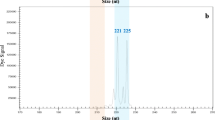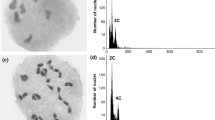Abstract
Three synthetic triploid seedlings were derived from a cross between maternal parent Populus × euramericana (Dode) Guinier and Populus nigra var. italica (Moench.) Koehne via embryo rescue by treating female floral buds with colchicine at certain developmental stages before and after pollination, and identified by flow cytometric analyses. A total of 21 microsatellite primers were used to infer the ploidy of gametes forming the hybrids and the underlying meiotic mechanism. The results suggest that 2n eggs originated from the maternal poplar, contributing the extra haploid genome in the triploids. In addition, first division restitution (FDR) 2n eggs were produced in the maternal tree according to the marker genotypes of these triploids. Cytological analyses of megasporogenesis revealed that meiosis of the maternal parent was asynchronous. This cytological evidence suggests that 2n eggs result from FDR after treatment with colchicine, as a portion of megaspore mother cells (MMCs) were within the first division at the post-pollination stage. These results aid in understanding the mechanism of 2n egg formation in poplar and make the utilization of 2n eggs in polyploid poplar breeding more effectively.





Similar content being viewed by others
References
Bradshaw HDJ, Stettler RF (1993) Molecular genetics of growth and development in Populus. I. Triploidy in hybrid poplars. Theor Appl Genet 86:301–307
Bretagnolle F, Thompson J (1995) Gametes with the somatic chromosome number: mechanisms of their formation and role in the evolution of autopolyploid plants. New Phytol 129:1–22
Brownfield L, Köhler C (2011) Unreduced gamete formation in plants: mechanisms and prospects. J Exp Bot 62:1659–1668
Cervera MT, Storme V, Ivens B, Gusmão J, Liu BH, Hostyn V, Slycken JV, Montagu MV, Boerjan W (2001) Dense genetic linkage maps of three Populus species (Populus deltoids, P. nigra and P. trichocarpa) based on AFLP and microsatellite markers. Genetics 158:787–809
Chen ZJ (2007) Genetic and epigenetic mechanisms for gene expression and phenotypic variation in plant polyploids. Annu Rev Plant Biol 58:377–406
Chen LZ, Lou QF, Zhuang Y, Chen JF, Zhang XQ, Wolukau JN (2007) Cytological diploidization and rapid genome changes of the newly synthesized allotetraploids Cucumis × hytivus. Planta 225:603–614
Chen CX, Lyon MT, O’Malley D, Federici CT, Gmitter J, Grosser JW, Chaparro JX, Roose ML, Gmitter FG (2008) Origin and frequency of 2n gametes in Citrus sinesis × Poncirus trifoliate and their reciprocal crosses. Plant Sci 174:1–8
Doležel J, Binarová P, Lucrettr S (1989) Analysis of nuclear DNA content in plant cells by flow cytometry. Biol Plant 31:113–120
Ewald D, Ulrich K, Naujoks G, Schroder MB (2009) Induction of tetraploid poplar and black locust plants using colchicine: chloroplast number as an early marker for selecting polyploids in vitro. Plant Cell Tiss Org 99:353–357
Hermsen JG (1984) Mechanisms and genetic implications of 2n gamete formation. Iowa State J Res 58:421–434
Huang QJ, Su XH, Zhang XH (2004) Genetic linkage mapping in F2 population of Populus deltoides × P.cathayana by using AFLP and SSR marker. Forest Res 17:291–299
Jafari Mofidabadi A, Modir-Rahmati AR, Tavesoli A (1998) Application of ovary and ovule culture in Populus alba L. × P. euphratica OLIV. hybridization. Silvae Genet 47:332–334
Kang XY (1996) Chromosome count and shape of poplar. J Gansu Agric Univ 31:67–70
Kang XY, Zhu ZT (1997) A study on the 2n pollen vitality and germinant characteristics of white poplars. Acta Bot Yunnanica 19:402–406
Kang XY, Zhu ZT, Zhang ZY (2000) Meiosis and its stages of pollen mother cells in Chinese white poplar. J Beijing Forest Univ 22:5–7
Kang XY, Zhang PD, Gao P, Zhao F (2004) Discovery of a new way of poplar triploids induced with colchicine after pollination. J Beijing Forest Univ 26:1–4
Levin DA (1983) Polyploidy and novelty in flowering plants. Am Nat 122:1–24
Li GP, Huang QC (2006) Ontogeny of pollen and pollination in Keteleeria fortune. Sci Silvae Sin 42:42–47
Li YH, Kang XY (2007) Triploid induction in white poplar by chromosome doubling of megaspore. J Beijing Forest Univ 29:22–25
Li Y, Zhu ZT, Tian YT, Zhang ZY, Kang XY (2001) Studies on obtaining triploids by colchicine treating female flower buds of white poplar. Sci Silvae Sin 37:68–74
Li YH, Kang XY, Wang SD, Zhang ZH, Chen HW (2008) Triploid induction in Populus alba × P. glandulosa by chromosome doubling of female gametes. Silvae Genet 57:37–40
Lim KB, Ramanna MS, de Jong JH, Jacobsen E, van Tuyl JM (2001) Indeterminate meiotic restitution (IMR): a novel type of meiotic nuclear restitution mechanism detected in interspecific lily hybrids by GISH. Theor Appl Genet 103:219–230
Liu B, Wendel JF (2003) Epigenetic phenomena and the evolution of plant allopolyploids. Mol Phylogenet Evol 29:365–379
Magnard JL, Yang M, Chen YCS, Leary M, McCormick S (2001) The Arabidopsis gene tardy asynchronous meiosis is required for the normal pace and synchrony of cell division during male meiosis. Plant Physiol 127:1157–1166
Masterson J (1994) Stomatal size in fossil plants: evidence for polyploidy in majority of angiosperms. Science 264:421–424
Matzke MA, Scheid OM, Matzke AJM (1999) Rapid structural and epigenetic changes in polyploid and aneuploid genomes. Bioessays 21:761–767
Nelson MN, Mason AS, Castello MC, Thomson L, Yan GJ, Cowling WA (2009) Microspore culture preferentially selects unreduced (2n) gametes from an interspecific hybrid of Brassica napus L. × Brassica carinata Braun. Theor Appl Genet 119:497–505
Nimura M, Kato J, Mii M (2006) Interspecific hybrid production by reciprocal crosses between Dianthus caryophyllus L. and Dianthus × isensis Hirahata et Kitamura. J Hortic Sci Biotech 81:995–1001
Osborn TC, Pires JC, Birchler JA, Auger DL, Chen ZJ, Lee HS, Comai L, Madlung A, Doerge RW, Colot V, Martienssen RA (2003) Understanding mechanisms of novel gene expression in polyploids. Trends Genet 19:141–147
Park TH, Kim JB, Hutten RCB, van Eck HJ, Jacobsen E, Visser RGF (2007) Genetic positioning of centromeres using half-tetrad analysis in a 4x-2x cross population of potato. Genetics 176:85–94
Pires JC, Zhao JW, Schranz ME, Leon EJ, Quijada PA, Lukens LN, Osborn TC (2004) Flowering time divergence and genomic rearrangements in resynthesized Brassica polyploids (Brassicaceae). Biol J Linn Soc 82:675–688
Ramanna M (1979) A re-examination of the mechanisms of 2n gamete formation in potato and its implications for breeding. Euphytica 28:537–561
Risso-Pascotto C, Pagliarini MS, do Valle CB, Jank L (2004) Asynchronous meiosis in an interspecific hybrid of Brachiaria ruziziensis and B. brizantha. Plant Cell Rep 23:304–310
Robinson JP (2006) DNA content measurement for DNA ploidy and cell cycle analysis. In: Darzynkiewicz Z, Juan G (eds) Current protocols in cytometry. Wiley, New York, pp 1–24
Schlarbaum SE (1991) Cytogenetics of forest tree species. In: Tsuchiya T, Gupta PK (eds) Chromosome engineering in plant genetics and breeding. Elsevier, Netherlands, pp 593–618
Shaked H, Kashkush K, Ozkan H, Feldman M, Levy AA (2001) Sequence elimination and cytosine methylation are rapid and reproducible responses of the genome to wide hybridization and allopolyploidy in wheat. Plant Cell 13:1749–1759
Song K, Lu P, Tang K, Osborn TC (1995) Rapid genome change in synthetic polyploids of Brassica and its implications for polyploid evolution. Proc Natl Acad Sci USA 92:7719–7723
Stebbins GL (1971) Chromosomal evolution in higher plants. Edward Arnold, London
Stebbins GL (1985) Polyploidy, hybridization and invasion of new habitats. Ann Mol Bot Gard 72:824–832
Tavoletti S (1994) Cytological mechanisms of 2n egg formation in a diploid genotype of Medicago sativa subsp. falcata. Euphytica 75:1–8
Udall JA, Quijada PA, Osborn TC (2005) Detection of chromosomal rearrangements derived from homeologous recombination in four mapping populations of Brassica napus L. Genetics 169:967–979
van der Schoot J, Pospíšková M, Vosman B, Smulders MJM (2000) Development and characterization of microsatellite markers in black poplar (Populus nigra L.). Theor Appl Genet 101:317–322
Veilleux R (1985) Diploid and polyploid gametes in crop plants: mechanisms of formation and utilization in plant breeding. Plant Breed Rev 3:253–288
Wang J, Kang XY, Li DL, Jing YC, Zhang ZH (2006) Meiosis and chromosome behavior of pollen mother cell in Populus simonii Carr. × P. nigra L. ‘Tongliao’. Acta Bot Boreali-Occident Sin 26:2231–2238
Wang J, Kang XY, Li DL, Jing YC, Yang WG (2007) Induction of allotriploid plants in Populus (Section Tacamahaca) with colchicine after pollination. J Being Forest Univ 29:18–21
Wang J, Kang XY, Li DL (2008) Chromocenter number and relationship between it and ploidy level in Populus. Acta Bot Boreali-Occident Sin 28:1968–1971
Wendel JF (2000) Genome evolution in polyploids. Plant Mol Biol 42:225–249
Zhang S, Qi L, Chen C, Li X, Song W, Chen R, Han S (2004) A report of triploid Populus of the section Aigeiros. Silvae Genet 53:69–75
Zhang SG, Yang WH, Sun XM, Li MX, Han SY, Wang JH, Wang XS, Qi LW (2007) Studies on the pollen mother cell meiosis and pollen development of Larix principis-rupprechtii. Acta Phytotaxon Sin 45:505–512
Zhang JF, Wei ZZ, Li D, Li BL (2009) Using SSR markers to study the mechanism of 2n pollen ormatiom in Populus × euramericana (Dode) Guinier and P. × popularis. Ann For Sci 66:53–62
Zhu ZT, Lin HB, Kang XY (1995) Studies on allotriploid breeding of Populus tomentosa B301 clones. Sci Silvae Sin 31:499–505
Acknowledgements
The authors would like to thank Dr. Paul Kretchmer at San Francisco Edit for revising the manuscript. This research was supported by the National Natural Science Foundation of China (No. 31070598), the key Project of the Chinese Ministry of Education (No. 109022), and Chinese Chang-Jiang Scholar funds.
Author information
Authors and Affiliations
Corresponding authors
Additional information
Communicated by A. Brunner
X. Xi and D. Li contributed equally to this work.
Rights and permissions
About this article
Cite this article
Xi, X., Li, D., Xu, W. et al. 2n egg formation in Populus × euramericana (Dode) Guinier. Tree Genetics & Genomes 8, 1237–1245 (2012). https://doi.org/10.1007/s11295-012-0510-y
Received:
Revised:
Accepted:
Published:
Issue Date:
DOI: https://doi.org/10.1007/s11295-012-0510-y




